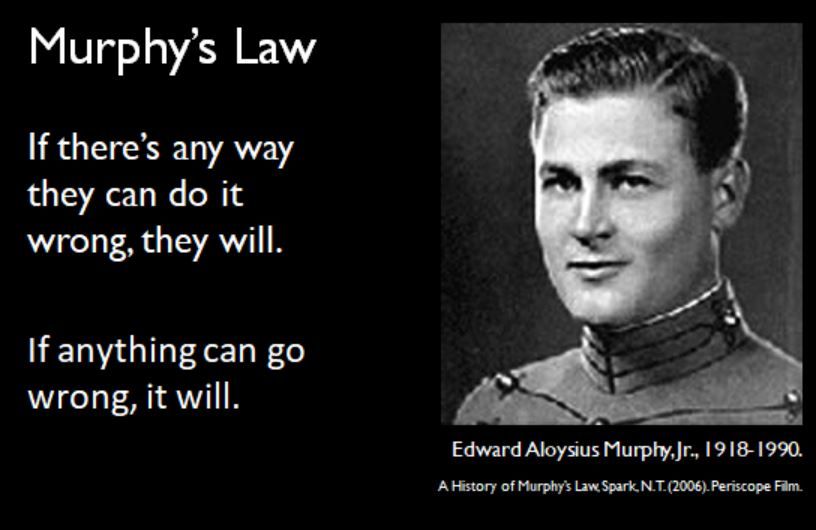Who invented Murphy's Laws?
Thanks to Murphy's Laws, which we hear often, we gain the courage and motivation to approach the sinister events that humorously happen to us, to cope with the problems, and to overcome the difficulties. But who is the person who invented these laws?

What is the concept of Murphy's Law?
Why is it called Murphy's Law?
Is Murphy's law based on a natural person?
What are Murphy's three laws?
Murphy's First Law: Anything that can go wrong will go wrong.
Murphy's Second Law: Nothing is as easy as it looks.
Murphy's Third Law: Everything takes longer than you think it will.
Murphy's Laws consist of interesting suggestions in the form of principles, recommendations, and aphorisms, which were first put forward by Edward Aloysius Murphy Jr in 1949 as a solution method or warning of danger in the face of various problems.
Edward Aloysius Murphy was born on January 11, 1918, in the Panama Canal Zone, the eldest of five children in the family. After graduating from high school in New Jersey, he enters the US Air Force Academy. He was accepted into the army in 1940, the year he graduated. After receiving pilot training, he served in India, China, and Myanmar in the Second World War. After the war, he was one of the engineers who experimented on rockets in the Air Force.
Edward Aloysius Murphy Jr. (January 11, 1918 – July 17, 1990[1]) was an American aerospace engineer who worked on safety-critical systems. He is best known for his namesake Murphy's law, which is said to state, "Anything that can go wrong will go wrong".
In 1949, at Edwards Air Force Base in California, the American Air Force's crash test research project, codenamed MX981, in which Murphy was a part, conducted a series of dangerous experiments on the human body's resistance to sudden acceleration. In the first experiments, models in human form are used. As for the human subjects, Colonel John Paul Stapp becomes the subject, and after 29 separate rides, the high speed of the rocket sled cracks his ribs and fractures his wrists.
At this stage, Edward Murphy recommends measuring with sensors connected to different parts of the body. It is a costly method, but it is tried. In the experiment, an accelerometer is attached to 16 other points on the pilot. The sensor can be attached in two ways with an adhesive, and one of the workers attaches all 16 sensors incorrectly. Murphy then expressed his anger at the technician who did it, saying, "If there's a way to do something wrong, this guy will find it." Seeing the comedic potential here, his colleagues named this phrase and its variations, Murphy's Laws, and it gradually spread and became famous.
At a later press conference, Colonel John Paul Stapp said that he owed Murphy's Law to survive the experiments. He will say, “We have considered all possibilities and calculated that things could go wrong, and took our precautions.” Murphy's Law, which the public met here, says in a nutshell, "Anything that can go wrong will go wrong". The original proposition reads: "If there are two or more ways to do something and one of them is going to end in disaster, one will find it."
Over time, many people add similar mishaps at work to the list called Murphy's Law, these rules become anonymous; even every profession causes Murphy's Law to occur. Perhaps one of the fields where Murphy's Laws are most popular is military service. Various principles of martial arts in various military units are listed under the Murphy Laws of War.
After Edward Murphy resigned from the US Air Force in 1952, he conducts rocket tests at Holloman Air Force Base, then returns to California to further his career on projects related to aircraft cabins. He works on 20th-century trials including the famous II F-4 Phantom, XB-70 Valkyrie, SR-71 Blackbird, B-1 Lancer, and X-15 type aircraft. He also took part in the Apollo project in the 1960s. He died on July 17, 1990.
According to Murphy's Law, if a business has the possibility of more than one outcome, and one of these possibilities will produce an undesirable outcome or disaster, then when something starts to go wrong, the worst-case scenarios will certainly occur in sequence.
If an event has a low probability of happening, it is either unlikely or impossible. On the other hand, Murphy's Laws approach the situation in reverse; If an event is possible, it will happen. In a simple sentence, chaos is more likely than order.
Some examples of Murphy's Laws:
- When the bread on which you spread jam falls, it will always be face down with jam.
- Every solved problem creates new problems.
- When a broken tool comes to be repaired, it always works.
- If something can go wrong, it will go wrong.
- Speak persuasively when you are unsure of yourself.
- A shortcut is the longest path between two points.
- No good deed goes unpunished.
- Whenever you turn on the radio, you will hear the ending melodies of your favorite song.
- The wrong number never rings busy.
- Your phone will never ring before you enter the bathroom.
- It's very clear if you don't understand.
- If everything is going perfectly, there must be something wrong somewhere.
- Don't be happy that the enemy is within range, you are within his range.
- Those who die first in war are those who have no fear. They are followed by those who fear the most.
- When you think you are not noticed, you are being watched by everyone.
